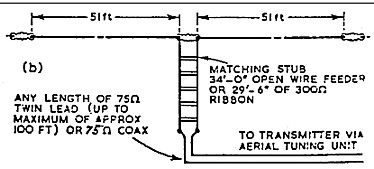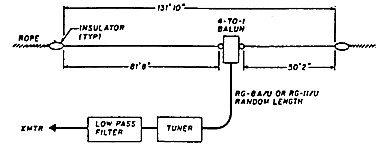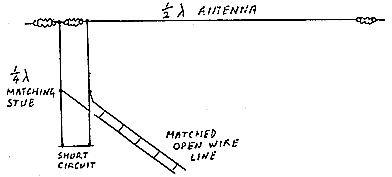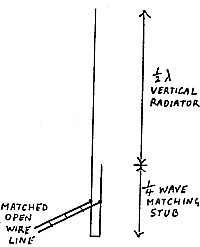|
Introduction In choosing a feeder system for antennas, preference is often give to the use of 50-ohm coaxial cable. This practice is often applied when, in fact, it might be more efficient, or even more convenient, to use balanced open wire lines. This article is devoted to pointing out the advantages of open wire lines and discussing a few particular applications where they might be the preferred choice to feed the antenna. Coaxial Cable Before turning to our open wire line discussion, we should first discuss the merits of coaxial cable, in particular the type with polythene dielectric as generally used in amateur radio. Typical values of characteristic impedance for this type of cable are 50 ohms and 75 ohms, very suitable values to match the radiation resistance of many basic antennas. Because of the concentric form of the two cable conductors, the coaxial cable fields are confined to within the inside of the cable bounded by the outer conductor. As there is little field on the outside of the outer conductor, the cable can be mounted directly on a metal support. Owing to this feature and also the flexible nature of the polythene dielectric, the cable is very suitable for running up the side of a metal tower or mast to the antenna on top. Furthermore, radiation directly from the cable is minimized because of the confined field. From a receiving point of view, the cable forms a transmission line which is shielded from direct signal pickup. This is an advantage if the cable must run through a high level field of localized noise. Tuned Feeders The operation of wire antennas multiband is often made a lot easier if the transmission line can be tuned. This of course implies a very high SWR. Suppose we select a value of SWR = 20, the highest value shown on the curves of figure 2. For this SWR, our RG59 coaxial cable has an attenuation of 6dB/100ft at 14MHz and 7.5dB/100ft at 28MHz. This is excessive attenuation and hence the coax cable is hardly suitable for operation in a tuned feeder mode. We now apply the SWR = 20 to the open wire TV cable and we get attenuation figures of around 0.8dB/100ft at 14MHz and 0.4dB/100ft at 28MHz. Quite clearly, open wire line is essential for good power efficiency when using tuned feeders. Some Typical Wire Antennas One of the most popular of multi-band wire antennas is the G5RV. A typical form of this antenna makes use of a 75 ohm twin lead or coaxial cable coupled via a matching stub of 300 ohm ribbon (refer figure 3). While a good SWR is achieved at 14MHz, it is reported to be as high as 6:1 at 7MHz and 21MHz and 4:1 at 28MHz (refer VK3AVO, AR April 1974 and December 1982). The alternative arrangement is to use 83ft of open wire line all the way to the centre of the antenna. Using this type of feed system, the attenuation is negligible for whatever SWR applies and, hence, it is the preferred system.
Figure 3: The G5RV
antenna with 75 ohm transmission line Considerable attention has recently been given in "Random Radiators" to various forms of the series fed or "Carolina" Windom antenna. A typical form of this antenna is shown in figure 4. An antenna impedance of around 200 to 300 ohms is assumed and this is coupled via a 4:1 or 6:1 impedance ratio balun transformer at the antenna connecting point. The balun transformer must be fitted in some sort of weatherproofing housing attached to the antenna in space Would it not he better to feed the antenna with 300 ohm TV open wire line (or similar) and fit the balun transformer in the radio shack? Not only would the transmission line have lower power loss, but a weatherproof fitting for the transformer would no longer be required.
Figure 4: The The
Carolina series fed Windom antenna using coaxial transmission line. End Fed Horizontal Antennas If the radio shack is nearer to one end of the wire antenna than its centre, it is often more convenient to end feed the antenna with a shorter length of feed line. The end of the antenna is a high impedance in the order of thousands of ohms, the actual value being dependent on the wire size and the number of half wavelengths along the wire. One method of matching this impedance to the lower impedance of a balanced transmission line is to tap in the line connection at the appropriate point on a quarter wave matching stub. (See figure 5). This is an efficient feed system but it is limited to single band operation.
Figure 5: End fed
half-wave antenna fed with open wire line and matched using a
quarterwave stub For multi -band operation of the end fed antenna, the open wire line is fed directly to the antenna end and operated in a tuned mode. The transmitter is interfaced with the line via a tuner with balanced output (refer figure 6). The end fed antenna has some different characteristics to its centre fed counterpart. At a frequency for which the antenna is one half wavelength long, the radiation pattern is similar. However, this is not so at higher multiples of a half wavelength. Take the case of the second harmonic operation in which the wire is one wavelength long. For the centre fed antenna, the two half waves are in phase, but for the end fed antenna, they are out of phase. The centre fed antenna concentrates its field in a bi-directional pattern whereas the end fed antenna has four main lobes giving a more omni-directional pattern.
Figure 6: End fed (Zepp)
antenna for multiband operation uses tuned feeders An interesting version of the end fed antenna is the end fed inverted V. Assuming this is cut for a half wavelength on 40 metres, it operates similarly to the centre fed inverted V on that band. On 20 metres, there are two half-wave sections as in the horizontal wire but the fields are around 90 degrees to each other (assuming a 90 degree V). In the horizontal plane, the fields are out of phase, but in the vertical plane, they are in phase and additive. It seems reasonable to assume that, on 20 metres, this antenna operates more like a vertical antenna with two broadside elements and a consequent low angle of radiation. The antenna can also be operated as three half waves on 15 metres and four half waves on 10 metres with even more complex radiation patterns. Such an antenna system has been described by Colin Dickman in "Radio ZS" as the "ZS6U Minishack Special". The articles concerned were also reprinted In QST and Amateur Radio. The end fed inverted V has been used as a multi-band antenna at the writer's home for many years and with considerable success. In this case on 20 metres, the open wire line is matched to the end of the antenna using the quarter wave matching stub. The shorting clip for the stub is just outside the radio shack door and on 40, 15 and 10 metres, the short is removed and the twin open wire line and part of the stub all become the tuned line used on these bands. On 80 metres, the feeder wires are paralleled and the antenna plus feeder and stub become a Marconi antenna operated against ground radials. On this band the radiator is a little over a quarter wave long. Lengths of Tuned Lines Tuned lines can be any length provided the antenna tuning system can cope with the impedance reflected down the line. Taking the example of the end fed antenna, odd multiples of a quarter wave will reflect very low impedance and even multiples very high impedance. Both these extreme conditions might present difficulties for the antenna tuning unit and line lengths which are multiples of a quarter wave should perhaps he avoided. Open Wire Line at VHF Most custom built VHF antennas are made to match directly into a 50 ohm coaxial cable and, generally speaking, feeding the antenna via a coaxial cable is the most convenient thing to do. Commonly used types of 50 ohm coaxial cable are RG58 and RG8. On two metres, RG58 has an attenuation factor of 4.5dB/100ft and RG8 has a factor of 3dB/100ft. If the transmission line is long, one might well consider open wire line as an alternative to the coax cable. The 300 ohm TV open wire line has an attenuation factor on two metres of only 0.75dB/100ft. An antenna in common use is the 10 element channel 5A TV Yagi which has been modified for 2m operation. The active element in this antenna is a folded dipole which presents a terminal impedance of around 300 ohms, specifically designed for 300 ohm ribbon cable or 300 ohm open wire line. Here is a case where the 300 ohm line can he run all the way to the antenna from the radio shack with lower loss than using the coaxial cable. At the transmitter end, a 75-300 ohm coaxial balun (as shown in figure 7) can be used to interface with the transmitter. The 75 ohm load to the transmitter might be a little high for the usual 50 ohm output but in practice it can work quite well.
Another antenna which is easily matched to the open wire line is the J antenna, figure 8. A half wave vertical radiator is connected at its lower end to a quarter wave matching stub. The open wire line is simply connected to the stub at an impedance point matching the line impedance. The position of the connecting taps can be set by experiment for minimum SWR on the transmission line.
Connecting to the Transmitter Most transceivers are designed for a resistive RF output load of 50 ohms. A 2:1 turns ratio balun transformer can be used to reflect 75 ohms from a 300 ohm balanced line which is properly matched. A transmitter with a valve output stage and adjustable loading control can usually accommodate the 75 ohms. A transmitter with a solid state output stage is likely to be more critical and require a more precise 50 ohm load. For the 300 ohm line, this calls for a 2.45:1 turns ratio transformer, a little more difficult to achieve using the normal multi-filar winding technique on a toroidal core. For tuned open wire lines or those with a high SWR, some form of balanced matching device is needed to interface with the transmitter. At HF, the Z match tuner has proved to be very useful for this purpose. Where a low loss transmission line is used, the main reason for adjusting to give a low SWR facing the transmitter is to present the correct load impedance to the transmitter This particularly applies to solid state output stages which are designed to protect themselves and shutdown if not correctly loaded. If the transmission line has low loss, standing waves on the transmission line are of little consequence. Reflected power is not all just lost as some writers have often indicated. When there are standing waves, the feeder line becomes part of a resonant circuit and in a low loss line, most of the reflected power is returned to the circuit. If the SWR is 1:1 at the transmitter output, power not consumed by the antenna can only be dissipated in the loss resistance of the transmission line and in the RF resistance of the tuning and coupling components.
|





